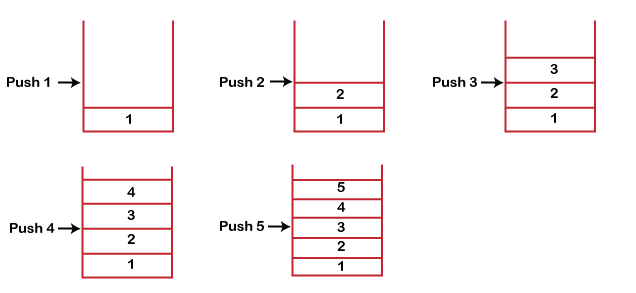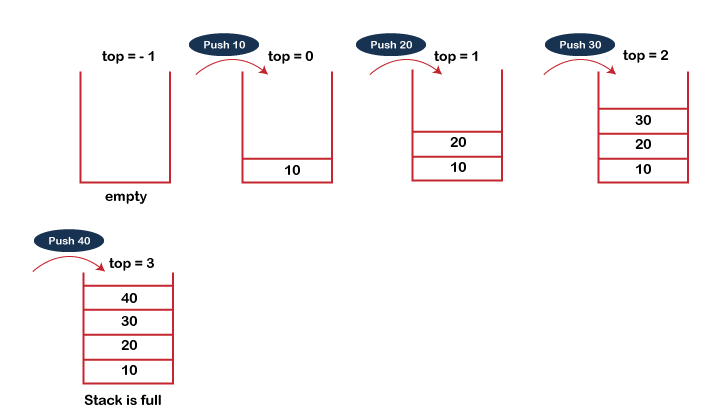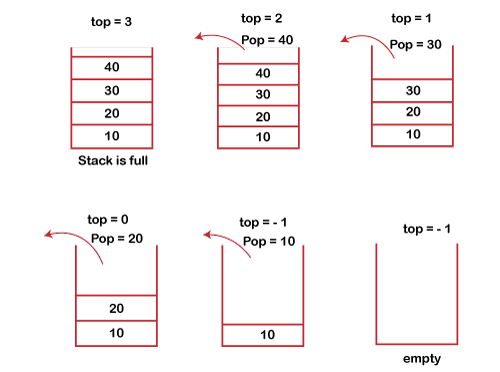TheDeveloperBlog.com
C-Sharp | Java | Python | Swift | GO | WPF | Ruby | Scala | F# | JavaScript | SQL | PHP | Angular | HTML
DS Stack
DS Stack with Introduction, Asymptotic Analysis, Array, Pointer, Structure, Singly Linked List, Doubly Linked List, Circular Linked List, Binary Search, Linear Search, Sorting, Bucket Sort, Comb Sort, Shell Sort, Heap Sort, Merge Sort, Selection Sort, Counting Sort, Stack, Qene, Circular Quene, Graph, Tree, B Tree, B+ Tree, Avl Tree etc.
What is a Stack?A Stack is a linear data structure that follows the LIFO (Last-In-First-Out) principle. Stack has one end, whereas the Queue has two ends (front and rear). It contains only one pointer top pointer pointing to the topmost element of the stack. Whenever an element is added in the stack, it is added on the top of the stack, and the element can be deleted only from the stack. In other words, a stack can be defined as a container in which insertion and deletion can be done from the one end known as the top of the stack. Some key points related to stack
Working of StackStack works on the LIFO pattern. As we can observe in the below figure there are five memory blocks in the stack; therefore, the size of the stack is 5. Suppose we want to store the elements in a stack and let's assume that stack is empty. We have taken the stack of size 5 as shown below in which we are pushing the elements one by one until the stack becomes full. 
Since our stack is full as the size of the stack is 5. In the above cases, we can observe that it goes from the top to the bottom when we were entering the new element in the stack. The stack gets filled up from the bottom to the top. When we perform the delete operation on the stack, there is only one way for entry and exit as the other end is closed. It follows the LIFO pattern, which means that the value entered first will be removed last. In the above case, the value 5 is entered first, so it will be removed only after the deletion of all the other elements. Standard Stack OperationsThe following are some common operations implemented on the stack:
PUSH operationThe steps involved in the PUSH operation is given below:

POP operationThe steps involved in the POP operation is given below:

Applications of StackThe following are the applications of the stack:
int main()
{
cout<<"Hello";
cout<<"javaTpoint";
}
As we know, each program has an opening and closing braces; when the opening braces come, we push the braces in a stack, and when the closing braces appear, we pop the opening braces from the stack. Therefore, the net value comes out to be zero. If any symbol is left in the stack, it means that some syntax occurs in a program.
Next TopicDS Array Implementation Stack
|
Related Links:
- Data Mining Architecture
- Data Structures | DS Tutorial
- Computer Network | Data Link Controls
- DS for symbols tables
- Data Preprocessing in Machine learning
- Data Mining Tools
- Data Mining vs Machine Learning
- What is Data Science: Tutorial, Components, Tools, Life Cycle, Applications
- DS Algorithm
- DS Asymptotic Analysis
- Data Flow in Angular 7 Forms
- Data Mining Tutorial
- Data Mining Cluster Analysis
- Data Mining vs Data Warehousing
- DS Structure
- DS Array
- DS 2D Array
- DS Quene
- Different types of Clustering Algorithm
- Data Mining vs Big Data
- Data Mining Bayesian Classification
- Data Mining World Wide Web
- Data Types in C
- Verbal Reasoning | Data Sufficiency 2
- Data Mining Techniques
- DS Introduction
- Data Structure Interview Questions (2021)
- Verbal Reasoning | Data Sufficiency 1
- Top 25 Data Science Interview Questions (2021)
- Data Warehouse Tutorial
- Data Flow in MapReduce
- DS Stack
- Data Abstraction in C++
- Top 25 Data Warehouse Interview Questions (2021)
- Data Link layer
- Data Security Considerations
- DS Pointer